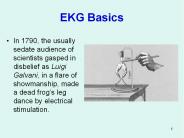WAVE Basics - PowerPoint PPT Presentation
1 / 24
Title:
WAVE Basics
Description:
WAVE Basics Chapters 15 What are Waves? A wave is a disturbance that transmits energy through matter or space. Types of Waves There are two types of waves: Mechanical ... – PowerPoint PPT presentation
Number of Views:135
Avg rating:3.0/5.0
Title: WAVE Basics
1
WAVE Basics
- Chapters 15
2
What are Waves?
- A wave is a disturbance that transmits energy
through matter or space.
3
Types of Waves
- There are two types of waves
- Mechanical Require a medium (matter through
which a wave travels) - Examples Include
- Ocean waves, medium water
- Sound waves, medium air
- Seismic Waves (Earthquake), medium earth
4
Types of Waves
- Electromagnetic caused by a disturbance in
electric and magnetic fields and do not require a
medium. - Examples include
5
Wave Movement
- A wave front is the front of a wave that is
transferring energy. - In a single system all of the wave fronts have
the same amount of energy, but as the wave front
spreads out, so does the energy.
6
Wave Movement
- Waves can move in two basic ways
- Transverse Motion particles of the medium
vibrate perpendicularly to the direction the wave
travels. - Example light wave
- Longitudinal (Compressional) Motion particles
of the medium vibrate parallel to the direction
the wave travels. - Example sound wave
7
Parts of a Wave
- You will be responsible for identifying parts of
a wave on both a transverse and longitudinal
wave. Complete the descriptions and label the
following on your note outline
8
Parts of a Wave
- Transverse Wave The top of the wave is called a
crest (peak) the bottom of the wave is called
the trough. - Longitudinal Wave The point of maximum
compression is called a compression The point
of least amount of compression is called a
rarefaction.
Crest
Trough
Compression
Rarefaction
9
Parts of a Wave
- Wavelength (?) is the total length of 1 wave.
- In transverse waves its typically measured from
crest to crest or trough to trough. - In longitudinal waves its measured from
compression to compression or rarefaction to
rarefaction. - The shorter the wavelength, the more energy the
wave is carrying.
1 ?
1 ?
1 ?
1 ?
10
Parts of a Wave
- Amplitude can be measured on a transverse wave.
It height from the resting point to the crest or
the resting point to the trough. - The larger the amplitude, the more energy the
wave is carrying.
Amplitude
Amplitude
11
Wave Measurements
- A period (T) is the time it takes for one full
wavelength of wave to pass a certain point. - A period is a measurement of time, so its SI unit
is seconds (s).
12
Wave Measurements
- The frequency (f) of a wave is the number of full
wavelengths that pass a given point per second. - The SI unit for measuring frequency is Hertz
(Hz).
13
Wave Measurements
- The frequency (f) of a wave is the number of full
wavelengths that pass a given point per second. - The SI unit for measuring frequency is Hertz
(Hz). - Frequency is the inverse of period
- f 1 / T
14
Wave Measurements
- Wave speed (v) is the speed at which a wave
passes through a medium and is measured using the
following equation - wave speed (m/s) frequency (Hz) x wavelength
(m) - v f x ?
15
Wave Measurements
- A wave along a guitar string has a frequency of
440 Hz and a wavelength of 1.5 m. What is the
speed of the wave?
v ? m/s f 440 Hz ? 1.5 m
v f ?
v 440 Hz x 1.5 m
v 660 m/s
16
Wave Measurements
- The speed of sound in air is about 340 m/s. What
is the wavelength of sound waves produced by
guitar strings vibrating at a frequency of 440 Hz?
v 340 m/s f 440 Hz ? ? m
? v / f
? 340 m/s / 440 Hz
? 0.77 m
17
Wave Measurements
- The speed of light is 3 x 108 m/s. What is the
frequency of microwaves with a wavelength of 0.01
m?
v 3 x 108 m/s 300,000,000 m/s f ? Hz ? 0.01
m
f v / ?
f 300,000,000 m/s / 0.01 m
f 30,000,000,000 Hz
18
Wave Behavior
- A reflection is the bouncing back of a wave as it
meets a surface or a boundary.
19
Wave Behavior
- How a wave reflects depends upon the surface that
it bounces off of. - Example When sending pulses down a rope with a
free end, the wave comes back normal. - Example When sending pulses down a rope with a
fixed end, the wave comes back inverted.
Free
Fixed
20
Wave Behavior
- Diffraction is the bending of a wave as it passes
an edge or an opening.
21
Wave Behavior
- Refraction is the bending of waves as they pass
from one medium to another.
22
Wave Behavior
- Interference occurs when the combination of two
or more waves exist in the same place at the same
time. - Constructive interference bigger wave.
- Destructive interference smaller wave.
23
Wave Behavior
- Standing waves are caused by two identical waves
going in opposite directions. - Series of constructive and destructive
interferences. - They have regions of no vibration (nodes) and
regions of maximum vibration (antinodes).
24
Wave Behavior
- The frequency of a wave can change when the
source of the wave or the observer is moving.
This is called the Doppler Effect.































